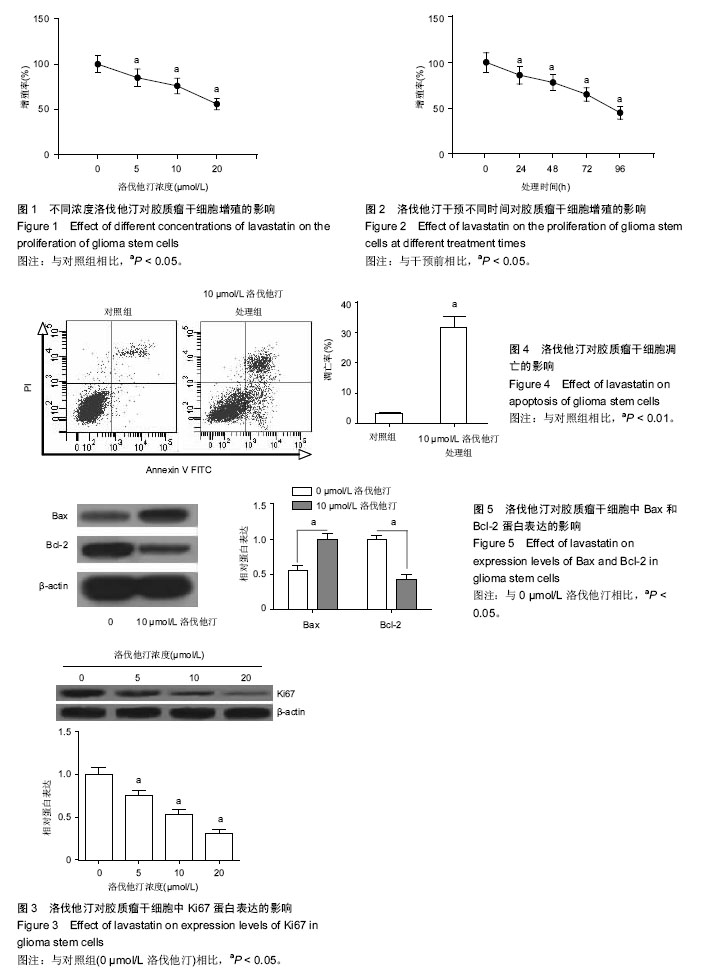| [1] Chen J, McKay RM, Parada LF. Malignant glioma: lessons from genomics, mouse models, and stem cells. Cell. 2012;149(1):36-47.
[2] Marumoto T, Saya H. Molecular biology of glioma. Adv Exp Med Biol. 2012;746:2-11.
[3] De Witt Hamer PC, Robles SG, Zwinderman AH, et al. Impact of intraoperative stimulation brain mapping on glioma surgery outcome: a meta-analysis.J Clin Oncol. 2012;30(20):2559-2565.
[4] 杨学军.恶性胶质瘤生物治疗的现状及前景[J].中华神经外科疾病研究杂志, 2013, 12(4): 289-292.
[5] Kasiske BL, Velosa JA, Halstenson CE, et al. The effects of lovastatin in hyperlipidemic patients with the nephrotic syndrome. Am J Kidney Dis. 1990;15(1): 8-15.
[6] Gupta EK, Ito MK. Lovastatin and extended-release niacin combination product: the first drug combination for the management of hyperlipidemia. Heart Dis. 2002; 4(2):124-137.
[7] 国风,岑建农,陈子兴,等. 胆固醇合成抑制剂洛伐他汀对 NB4 细胞体外作用的研究[J]. 中华血液学杂志, 2001, 22(11): 584-588.
[8] Rao S, Porter DC, Chen X, et al. Lovastatin-mediated G1 arrest is through inhibition of the proteasome, independent of hydroxymethyl glutaryl-CoA reductase. Proc Natl Acad Sci U S A. 1999;96(14):7797-7802.
[9] Dimitroulakos J, Thai S, Wasfy GH, et al. Lovastatin induces a pronounced differentiation response in acute myeloid leukemias.Leuk Lymphoma. 2000;40(1-2): 167-178.
[10] Xia Z, Tan MM, Wong WW, et al. Blocking protein geranylgeranylation is essential for lovastatin-induced apoptosis of human acute myeloid leukemia cells. Leukemia. 2001;15(9):1398-1407.
[11] Yu J, Man J, Jocelyn S, et al. Semaphorin 3C mediates glioma stem cell tumorigenicity and radioresistance. Cancer Research. 2015; 75(23 Supplement): A45.
[12] Gao X, McDonald JT, Hlatky L, et al. Acute and fractionated irradiation differentially modulate glioma stem cell division kinetics. Cancer Res. 2013;73(5): 1481-1490.
[13] Park SY, Piao Y, Tiao N,et al. TGF beta regulates tumor resistance to antiangiogenic therapy through POSTN in glioma stem cell models.Cancer Res. 2015; 75(15 Supplement):1385.
[14] Ignatova TN, Kukekov VG, Laywell ED, et al. Human cortical glial tumors contain neural stem-like cells expressing astroglial and neuronal markers in vitro. Glia. 2002;39(3):193-206.
[15] Yamada R, Nakano I. Glioma stem cells: their role in chemoresistance. World Neurosurg. 2012;77(2): 237-240.
[16] Zhao Y, Huang Q, Zhang T, et al. Ultrastructural studies of glioma stem cells/progenitor cells. Ultrastruct Pathol. 2008;32(6):241-245.
[17] Brescia P, Ortensi B, Fornasari L, et al. CD133 is essential for glioblastoma stem cell maintenance. Stem Cells. 2013;31(5):857-869.
[18] 王淑为,张剑宁,郭欣茹,等. 25 例恶性胶质瘤中肿瘤干细胞的分离与检测[J].中华神经外科疾病研究杂志, 2013, 12(4): 314-317.
[19] 张明菲,陆伟跃. 脑胶质瘤干细胞及干预策略研究进展[J].世界临床药物, 2015, 36(3): 204-209.
[20] Kramer E, Herman O, Frand J, et al. Ki67 as a biologic marker of basal cell carcinoma: a retrospective study. Isr Med Assoc J. 2014;16(4):229-232.
[21] Polley MY, Leung SC, McShane LM, et al. An international Ki67 reproducibility study. J Natl Cancer Inst. 2013;105(24):1897-1906.
[22] Follis AV, Llambi F, Merritt P,et al.Pin1-Induced Proline Isomerization in Cytosolic p53 Mediates BAX Activation and Apoptosis.Mol Cell. 2015;59(4): 677-684.
[23] Colin J, Garibal J, Clavier A, et al. Screening of suppressors of bax-induced cell death identifies glycerophosphate oxidase-1 as a mediator of debcl-induced apoptosis in Drosophila. Genes Cancer. 2015;6(5-6):241-253.
[24] Czabotar PE, Lessene G, Strasser A, et al. Control of apoptosis by the BCL-2 protein family: implications for physiology and therapy.Nat Rev Mol Cell Biol. 2014; 15(1):49-63.
[25] Volkmann N, Marassi FM, Newmeyer DD, et al.The rheostat in the membrane: BCL-2 family proteins and apoptosis.Cell Death Differ. 2014;21(2):206-215.
[26] Wei Y, Jiang Y, Zou F, et al. Activation of PI3K/Akt pathway by CD133-p85 interaction promotes tumorigenic capacity of glioma stem cells.Proc Natl Acad Sci U S A. 2013;110(17):6829-6834.
[27] Holmberg Olausson K, Maire CL, Haidar S, et al. Prominin-1 (CD133) defines both stem and non-stem cell populations in CNS development and gliomas. PLoS One. 2014;9(9):e106694.
[28] Chau MJ, McCrary MR, Mukherjee S, et al. Microenvironmental influences on glioma stem cell migration. Cancer Research. 2015; 75(15 Supplement): 5217.
[29] Fessler E, Borovski T, Medema JP. Endothelial cells induce cancer stem cell features in differentiated glioblastoma cells via bFGF. Mol Cancer. 2015;14:157.
[30] Venere M, Hamerlik P, Wu Q,et al.Therapeutic targeting of constitutive PARP activation compromises stem cell phenotype and survival of glioblastoma- initiating cells. Cell Death Differ. 2014;21(2):258-269.
[31] Lehnus KS, Donovan LK, Huang X, et al. CD133 glycosylation is enhanced by hypoxia in cultured glioma stem cells.Int J Oncol. 2013;42(3):1011-1017.
[32] Bostad M, Berg K, Høgset A, et al. Photochemical internalization (PCI) of immunotoxins targeting CD133 is specific and highly potent at femtomolar levels in cells with cancer stem cell properties. J Control Release. 2013;168(3):317-326.
[33] Jin X, Jin X, Jung JE, et al. Cell surface Nestin is a biomarker for glioma stem cells. Biochem Biophys Res Commun. 2013;433(4):496-501.
[34] 周永,糜漫天,朱俊东,等.洛伐他汀对MCF-7细胞增殖分化功能及间隙连接细胞通讯的影响[J].癌症, 2003, 22(3): 257-261.
[35] Marcelli M, Cunningham GR, Haidacher SJ, et al. Caspase-7 is activated during lovastatin-induced apoptosis of the prostate cancer cell line LNCaP. Cancer Res. 1998;58(1):76-83.
[36] Agarwal B, Bhendwal S, Halmos B, et al. Lovastatin augments apoptosis induced by chemotherapeutic agents in colon cancer cells. Clin Cancer Res. 1999; 5(8):2223-2229.
[37] 刘磊,龚彪,别里克,等.洛伐他汀联合KRN633对胆管癌细胞株QBC939生物学行为的影响[J].胃肠病学和肝病学杂志, 2012, 20(11): 1054-1059.
[38] 刘明,刘熙鹏,丁奇,等.瑞舒伐他汀对人胶质瘤 U251 细胞增殖和凋亡的影响[J]. 现代药物与临床, 2016, 31(4): 415-418.
[39] Guessous F, Zhang Y, Kofman A, et al. microRNA-34a is tumor suppressive in brain tumors and glioma stem cells. Cell Cycle. 2010;9(6):1031-1036.
[40] Lomonaco SL, Finniss S, Xiang C, et al. The induction of autophagy by gamma-radiation contributes to the radioresistance of glioma stem cells.Int J Cancer. 2009; 125(3):717-722.
[41] Wang J, Wakeman TP, Lathia JD, et al. Notch promotes radioresistance of glioma stem cells. Stem Cells. 2010;28(1):17-28. |
.jpg)

.jpg)
.jpg)